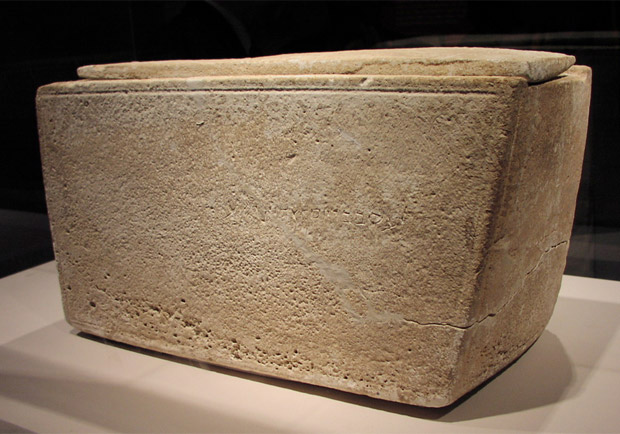For nine years, it was the centerpiece of the Israel Antiquities Authority's (IAA) campaign against forgers and smugglers. Now it sits in a warehouse near Jerusalem—its future uncertain.
It's a small stone box—the type used to collect bones for burial in first-century Jerusalem. Carved on its side is an inscription: "James, son of Joseph, brother of Jesus." The ossuary is unquestionably 2,000 years old. The inscription, though, is a matter of contention.
Oded Golan, the Tel Aviv antiquities collector to whom it belongs, was found not guilty in March of all but 3 of the most minor of the 44 charges brought against him. So far there's been no indication that the IAA will be returning the ossuary or any of the other antiquities seized from Golan, despite a Jerusalem district judge's ruling that the IAA had failed to prove its case.
"They object to returning the pieces to me," said Golan. "They took hundreds of antiquities from my home and my storage." He is unwilling to talk in detail about the case until he knows whether the IAA is going to appeal.
Hershel Shanks, who first revealed the ossuary to the public in the pages of Biblical Archaeology Review magazine in 2002, has never wavered. "I think it's clear that it's authentic," he said. In the just-released July/August 2012 issue of the review, Shanks summarizes the evidence:
- Two of the world's top paleographers, Ada Yardenit and Andre Lemaire, agree the inscription is authentic and "no other paleographer has offered a substantive critique of their work."
- Tel Aviv University clay specialist Yuval Goren, who charged that the ossuary's patina was forged, admitted on the witness stand that he also saw authentic patina inside some of the letters—including in the last word of the inscription.
- Former IAA employee Joe Zias, who first raised the issue of forgery when he claimed that he saw the ossuary in an antiquities shop without the second half of the inscription, admitted at the trial that he might have seen a different ossuary.
- A statistical analysis by Tel Aviv University professor Camil Fuchs of ancient Jewish names concludes that there were only 1.71 people "named James with a father Joseph and a brother named Jesus" at the time of the ossuary's use.
Evangelical archaeologists and Bible scholars polled by Christianity Today about the ossuary inscription have sharply diverging views. Of the 16 who responded, eight believe the inscription is authentic, while two do not. Six are not sure.
Even those who believe the inscription is authentic are split almost equally between those who think the ossuary is an important artifact because of its possible connection to Jesus of Nazareth, and those who are dismissive because it's almost impossible to ever know with any certainty that the ossuary held the remains of Jesus' brother.
"I think the ossuary deserves careful study, even if unprovenanced [of unknown origin]," said Craig Evans, professor of New Testament at Acadia University in Nova Scotia. "Many important and unprovenanced artifacts are in museums; for example, the Rosetta Stone. To ignore them would be foolish."
Ben Witherington, professor of New Testament at Asbury Theological Seminary in Kentucky, wrote a book on the ossuary with Shanks. He also maintains the inscription's authenticity.
Witherington says the last part of the inscription—"the brother of Jesus"—is more than just a postscript.
"In an honor and shame culture, this is a form of bragging," he said. "But who would be bragging about being related to someone who died on a cross? In short, the inscriber of the box believed that Jesus had been vindicated by God beyond that grisly, shameful death. First Corinthians 15:7 reports that James saw Jesus after his death."
On the other hand, Eckhard Schnabel, professor of New Testament at Trinity Evangelical Divinity School, disagrees. "The inscription is not authentic," he said. "The jury is no longer out."
"Even though the prosecutors may have messed up the case, the IAA was right to be suspicious," said Lawrence Geraty, professor of archaeology and Old Testament at LaSierra University. "There are still too many questions about this inscription."
Shanks believes the questions that have been raised so far are without substance. "Where's the evidence of forgery?" he said. "All I want is the truth. I certainly don't want scholars to cast a doubt on this for reasons that are not solid."
But Shanks recognizes that changing perceptions about the ossuary and its inscription will not be quick or easy. "It's going to take a generation."









